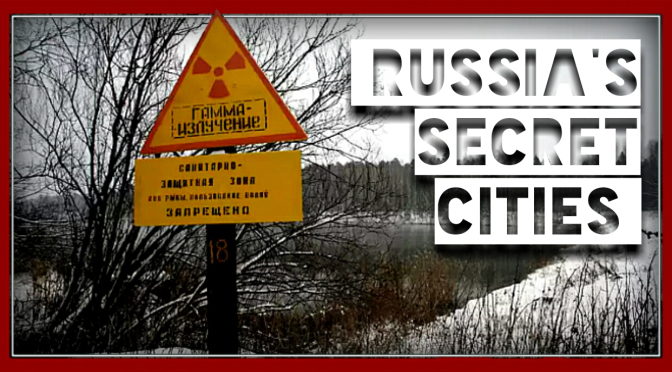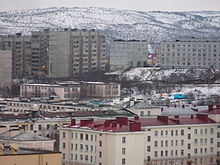ZATO: Russia’s 42 Top Secret Cities which you can’t visit & which are not on any maps!
[People have not believed me in some of my videos when I say that even in this modern age you can hide a tremendous amount of things. Well, can you believe it, you can hide entire cities. Area 51 type of security is not just limited to the USA. In fact, you can hide a city of a million people with no problem!
If you want proof that Apartheid/Segregation works, look no further than the Russian secret cities. You will see that they are safer than normal cities because movement into and out of them is highly restricted!
A Jewess I knew was married to a rich Afrikaner. I visited them a number of times. The rich Afrikaner (who was very Liberal I might add), had dealt with the Russians in business on a number of occasions. He told me that on one of these occasions he went to Russia and met with Russian Generals face to face. He said to me that there is a city in Russia, with a population of 1 million people and that everyone in that city works on only one thing: Building nuclear weapons to attack the USA with.
I came across this article in a slide show about Russia and it reminded me of what this Afrikaner had told me. He said the Russian Generals have an INTENSE hatred of the USA. (Think of that … their former ally in WW2 – morons!). In this slide show they mention that there are 42 secret Russian cities that you won’t find on any map. I suspect that all of them have to do with military activity, especially the manufacture of weapons and especially related to nuclear weapons. Jan]
Source: http://www.directexpose.com/russia-facts-never-knew/8/
Here is what Wikipedia has to say about these Closed Cities:
Closed city
A closed city or closed town is a settlement where travel or residency restrictions are applied so that specific authorization is required to visit or remain overnight. They may be sensitive military establishments or secret research installations which require much more space or freedom than is available in a conventional military base. There may also be a wider variety of permanent residents including close family members of workers or trusted traders who are not directly connected with its clandestine purposes.
Many closed cities existed in the Soviet Union. After 1991, a number of them still existed in the CIS countries, especially Russia. In modern Russia, such places are officially known as “closed administrative-territorial formations”
Structure and operations
Sometimes closed cities may only be represented on classified maps which are not available to the general public. In some cases there may be no road signs or directions to closed cities, and they are usually omitted from railroad time tables and bus routes.
Sometimes closed cities may be indicated obliquely as a nearby insignificant village, with the name of the stop serving the closed city made equivocal or misleading. For mail delivery, a closed city is usually named as the nearest large city and a special postcode e.g. Arzamas?16, Chelyabinsk?65. The actual settlement can be rather distant from its namesakes; for instance, Sarov, designated Arzamas-16, is in the federal republic of Mordovia, whereas Arzamas is in the Nizhny Novgorod Oblast (roughly 75 kilometres (47 mi) away). People not living in a closed city were subject to document checks and security checkpoints, and explicit permission was required for them to visit.[1] To relocate to a closed city, one would need security clearance by the organization running it, such as the KGB in Soviet closed cities.
Closed cities were sometimes guarded by a security perimeter with barbed wire and towers. The very fact of such a city’s existence was often classified, and residents were expected not to divulge their place of residence to outsiders. This lack of freedom was often compensated by better housing conditions and a better choice of goods in retail trade than elsewhere in the country. Also, in the USSR, people working with classified information received a salary bonus.
Soviet Union closed cities
Closed cities were established in the Soviet Union from the late 1940s onwards under the euphemistic name of “post boxes”, referring to the practice of addressing post to them via mail boxes in other cities. They fell into two distinct categories.
- The first category comprised relatively small communities with sensitive military, industrial, or scientific facilities, such as arms plants or nuclear research sites.[2] Examples are the modern towns of Ozyorsk (Chelyabinsk-65) with a plutonium production plant, and Sillamäe, the site of a uranium enrichment facility. Even Soviet citizens were not allowed access to these places without proper authorization. In addition to this, some bigger cities were closed for unauthorized access to foreigners, while they were freely accessible to Soviet citizens. These included cities like Perm, a center for Soviet tank production, and Vladivostok, the headquarters and primary base of the Soviet Pacific Fleet.
- The second category consisted of border cities (and some whole border areas, such as the Kaliningrad Oblast, Saaremaa, and Hiiumaa) which were closed for security purposes. Comparable closed areas existed elsewhere in the Eastern bloc; a substantial area along the inner German border and the border between West Germany and Czechoslovakia was placed under similar restrictions (although by the 1970s foreigners could cross the latter by train). Citizens were required to have special permits to enter such areas.
The locations of the first category of the closed cities were chosen for their geographical characteristics. They were often established in remote places situated deep in the Urals and Siberia, out of reach of enemy bombers. They were built close to rivers and lakes which were used to provide the large amounts of water needed for heavy industry and nuclear technology. Existing civilian settlements in the vicinity were often used as sources of construction labour. Although the closure of cities originated as a strictly temporary measure which was to be normalized under more favorable conditions, in practice the closed cities took on a life of their own and became a notable institutional feature of the Soviet system.[3]
Movement to and from closed areas was tightly controlled. Foreigners were prohibited from entering them and local citizens were under stringent restrictions. They had to have special permission to travel there or leave, and anyone seeking residency was required to undergo vetting by the NKVD and its successor agencies. Access to some closed cities was physically enforced by surrounding them with barbed wire fences monitored by armed guards.
The “box”
“Box” was the unofficial name of a secret Soviet facility much like the closed city, but smaller, usually the size of a factory. The “box” name was usually classified, as were the activities there. Incoming mail was addressed to “mailbox #XXXX”, thus the name of “box”. Most Soviet design bureaus for weapons, aircraft, space, military electronics, etc. were “boxes”.[citation needed]
Closed cities in post-Soviet states
Russia
Russia has the largest number of closed cities. The policy of closing cities underwent major changes in the late 1980s and early 1990s. Some cities, such as Perm, were opened well before the fall of the Soviet Union; others, such as Kaliningrad and Vladivostok, remained closed until as late as 1992. The adoption of a new constitution for the Russian Federation in 1993 prompted significant reforms to the status of closed cities, which were renamed “closed administrative-territorial formations” (or ZATO, after the Russian acronym). Municipally all such entities have a status of urban okrugs, as mandated by the federal law.
There are currently 44 publicly acknowledged closed cities in Russia with a total population of about 1.5 million people. 75% are administered by the Russian Ministry of Defense, with the rest being administered by Rosatom.[4] Another 15 or so closed cities are believed to exist, but their names and locations have not been publicly disclosed by the Russian government.[5]
Some Russian closed cities are open for foreign investment, but foreigners may only enter with a permit. An example is the Nuclear Cities Initiative (NCI), a joint effort of the United States National Nuclear Security Administration and Minatom, which involves in part the cities of Sarov, Snezhinsk, and Zheleznogorsk.
The number of closed cities has been significantly reduced since the mid-1990s. However, on 30 October 2001, foreign travel (without any exceptions) was restricted in the northern cities of Norilsk, Talnakh, Kayerkan, Dudinka, and Igarka. Russian and Belarusian citizens visiting these cities are not required to have any permits, however, local courts are known to deport Belarusian citizens[6] in contradiction with federal Constitution.
Krasnoyarsk-26 in Siberia, researched for the subject of Sidney Sheldon‘s 2001 fictional murder mystery-romance The Sky is Falling,[7] was planned in 2003 to be shut down by 2011,[8] in co-operation with the U.S, and documented by their Natural Resources Defense Council,[9] but actually closed in 2008.[10]
The number of closed cities in Russia is defined by government decree (see links further). They include the following cities. Reasons for restrictions are denoted in the descriptions below.
Source: https://en.wikipedia.org/wiki/Closed_city
Here are more articles and proof of Russia’s Secret Cities:
- Russia’s Secret City 40 Is A Prison Of Nuclear Waste And Death – https://www.huffingtonpost.ca/samira-goetschel/ozersk-city-40-russia_b_9857470.html
- Zarechny: a rare glimpse into one of Russia’s last closed cities – https://www.theguardian.com/world/gallery/2014/jun/16/zarechny-russia-closed-cities
- A sheltered existence: Life in Russia’s closed cities – https://www.rbth.com/politics_and_society/2016/05/02/a-sheltered-existence-life-in-russias-closed-cities_588975
- Inside Russia’s Closed Cities – http://fotoroom.co/zato-closed-cities-sergey-novikov/






